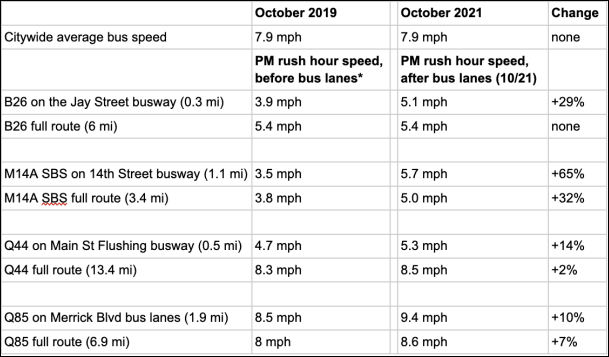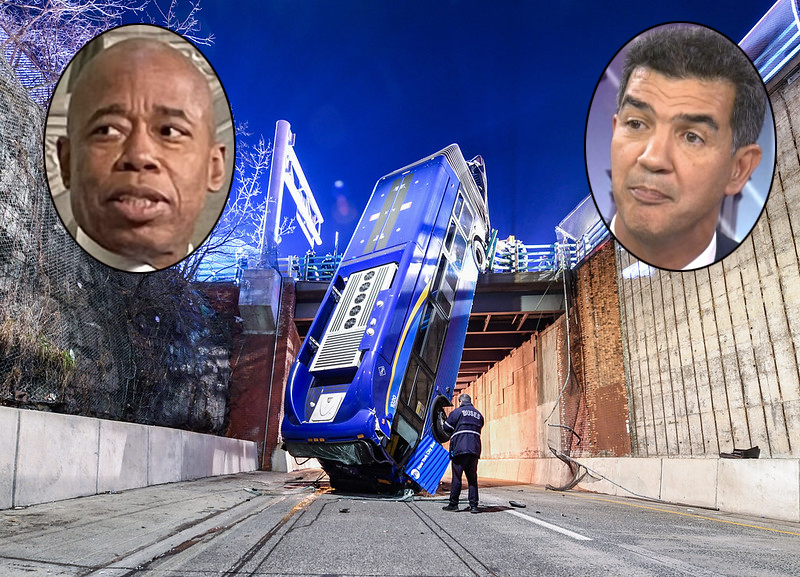Same place, same cry.
Advocates for long-suffering bus riders massed at Brooklyn Borough Hall on Monday morning, the same Greek Revival landmark where they campaigned for better bus service in 2016, to deliver the same basic message: This City Hall must do better than the last one in improving bus service.
The main difference between the 2016 rally and the one in 2022? A guy named Eric Adams — the Brooklyn Borough President, now mayor — and a guy named Ydanis Rodriguez — then a Council Member, now head of the Department of Transportation — were featured speakers in 2016. On Monday, they were absent.
But so much remains the same: When the Bus Turnaround Coalition came together for the first time, buses averaged just 7.4 miles per hour and ridership was fleeing. By 2019, buses reached a 7.9-mile-per-hour citywide average. They even made it to 8 mph, thanks to bus priority projects like the 14th Street Busway and its offspring in Downtown Brooklyn, Jamaica, Flushing and Washington Heights, but when car traffic returned to the city as the pandemic subsided, buses returned to a 7.8-mile-per-hour citywide average.

Fortunately, Mayor Adams has said that improving bus service is a key equity issue for him (just like the last mayor said). Advocates in the Coalition — which includes Riders Alliance, TransitCenter, Tri-State Transportation Campaign and the Straphangers Campaign — are growing impatient to hear specifics.
"We know that they support the [bus lane] mileage goal in the Streets Master Plan," said Ben Fried of TransitCenter. "But we want to see where they are going to put the bus lanes, how they're going to provide the resources to the bus program at DOT, how they're going to keep bus lanes clear. All those specifics and details are what we need to see to know that the City Hall is actually committed to improving service."
A new report from the coalition features an updated set of demands from the initial push, such as a demand that the MTA implement all-door boarding and complete its borough-wide route redesigns to better reflect where riders need to go (The MTA said last summer that it would run a pilot all-door boarding system on 10 local bus routes, but that pilot is stuck in neutral — and only the Bronx bus redesign is set to debut this year).
Bus service has faced institutional hurdles in the past, but maybe not under this mayor.
"I think that one of the [things that] clicked for Adams [about buses] is not just as an equity issue, but also as an efficiency issue," said Riders Alliance Director of Policy and Communications Danny Pearlstein. "The city can't make room for cars in a way that would make driving easier. The laws of physics are against it."
The physics of how much space cars take up is only one major impediment. The other is creating efficient bus routes.
Unfortunately, the Queens route redesign never made it out of the draft stage, with its lasting image that of then-New York City Transit President Andy Byford attempting to sell the new bus map to infuriated Queens residents at packed indoor public meetings just before coronavirus swept through New York City (and he swept out).
The redesigns, which will update maps that are in some cases over a century old, haven't caught up to interborough travel patterns or travel patterns upended by the pandemic, which Comptroller Brad Lander noted on Monday focused much less on getting into Manhattan and more on getting around nearby neighborhoods.
"No amount of finger-wagging is going to change the fact that there's going to be more remote work after the pandemic than there was before the pandemic," he said at the rally. "Not as many people will be riding the subway out of lower Manhattan, but a lot more people working near home in the outer boroughs needing buses to get there."
The coalition also urged City Hall to "empower the DOT commissioner to make ambitious changes" that benefited bus riders. Data shows that when the city gives buses priority, bus speeds have improved (shocking stuff, right?). For example, the B26 jumped from 3.1 miles per hour before the creation of the Jay Street busway to 5.1 miles per hour after Mayor de Blasio painted the roadway red. In Queens, the Q44 jumped from 4.7 miles per hour to 5.3 miles an hour along the Main Street Busway after it was created. (Other successes are below):

Will Rodriguez build on that small momentum? It depends on the mayor.
"To make bold changes for bus riders, the DOT chief needs to know the mayor has confidence in the plan and won’t back down when the inevitable resistance hits," the coalition wrote in its report.
The ultimate message of Monday's rally was one of bitter disappointment in the face of literally no controversy.
"When our organizations launched this campaign for better buses in 2016, we recommended a set of practical strategies to reform the bus," said TransitCenter Deputy Executive Director Tabitha Decker. "Fast forward to today and the city and the state have promised to adopt nearly all of the changes that we recommended. But they have yet to implement or fully scale those solutions across the city."
City Hall and the DOT claim they're listening, but that specifics are not on the immediate agenda.
"We have worked closely with the MTA, advocates, and community residents to significantly improve bus speeds, but there is much more work to do — that’s why Mayor Adams and I have a bold plan to create 150 miles of new busways and bus lanes across the city, speeding up buses and reducing wait times for New Yorkers," Rodriguez said in a statement issued after the rally.






